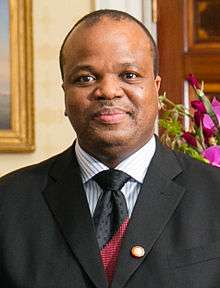Succession to the Swazi throne
| King of Swaziland | |
|---|---|
|
| |
| Incumbent | |
 | |
| Mswati III | |
| Details | |
| Style | His Majesty |
| Heir apparent | None |
| First monarch | Ngwane III |
| Formation | 1750s |
In Swaziland, no king can appoint his successor. Only an independent special traditional Council called the Liqoqo decides which of the wives shall be "Great Wife" and "Indlovukazi" (She-Elephant / Queen Mother). The son of this "Great Wife" will automatically become the next king.[1]
The "Great Wife" is chosen after the death of the king and must be of good character. Her character affects her child's chances of ascending to the status of king. According to Swazi culture, a son cannot be the heir if his mother is not of good standing. She must not bear the maiden name of Nkhosi-Dlamini as Dlamini is the name of the Royal House of Swaziland and she must not be a ritual wife (consequently the eldest son is never the heir).[2]
The king currently has fifteen wives and 23 children.[3] A Swazi king's first two wives are chosen for him by the national councillors. These two have special functions in rituals and their sons can never become kings. The first wife must be a member of the Matsebula clan, the second of the Motsa clan. These wives are known as tesulamsiti.
A royal fiance is called liphovela, or "bride". They graduate from being fiancées to full wives as soon as they fall pregnant, when the king customarily marries them. But the traditional marriage, known as “Ludvendve” (marriage to the king) only follows later.[4]
In traditional Swazi culture, the king is expected to marry a woman from every clan in order to cement relationships with each part of Swaziland. This means that the king must have many wives.[2]
- Inkhosikati (Queen) LaMatsebula—Ritual wife. Has a degree in Psychology.
- Son: HRH Prince Sicalo
- Son: Prince Maveletiveni
- Inkhosikati LaMotsa—Ritual wife. United Nations Development Programme (UNDP) Goodwill Ambassador since 1996.[5]
- Son: Prince Majahonkhe (1991)
- Son: Prince Buhlebenkhosi
- Son: Prince Lusuku
- Son: Prince Sinawonkhe

- 1986 Inkhosikati LaMbikiza—(born June 16, 1969 as Sibonelo Mngomezulu) Daughter of Percy Mngomezulu; an advocate, received her degree from UNISA. LaMbikiza is involved in the Swazi Royal Initiative to Combat AIDS (RICA). The initiative involves the recording of songs by Swazi, South African and international artists and the proceeds of the sales are allocated to programmes aimed at helping people affected by AIDS.[6]
- Daughter: Princess Sikhanyiso Dlamini (1987)
- Son: Prince Jabree Dlamini (Lindani)
- Son: Prince Makhosini "Omari" Dlamini (from a previous relationship, placed under the guardianship of LaMbikiza)"
- Inkhosikati LaNgangaza —(born Carol Dlamini) [Patron of world organisation "Hospice at Home" previously headed by Diana, Princess of Wales.
- Daughter: Princess Temaswati Dlamini (1988)
- Daughter: Princess Tiyandza Dlamini (1992)
- Daughter: Princess Tebukhosi Dlamini (1994)
- Daughter: Princess Wesive Dlamini (2012)
- Putsoana Hwala—(born 1974 ??) Known as Inkhosikati LaHwala She left the king on June 24, 2004 and moved to South Africa.[7]
- Son: Prince Bandzile (1990)
- Daughter: Princess Temashayina (1994)
- Delisa Magwaza—(born 1974 ??) Known as Inkhosikati LaMagwaza. She also left the king in 2004, after having an affair.[7] She married a South African businessman, with whom she has a child.[4]
- Daughter: Princess Temtsimba Dlamini (1992)
- Daughter: Princess Sakhizwe Dlamini (1999)
- August 2000 Inkhosikati LaMasango—(born 1981 ?? as Senteni Masango)
- Daughter: Princess Sentelweyinhosi (2000)
- Daughter: Princess Sibusezweni (2003)
- December 1998 Inkhosikati LaGija—(born Angel Dlamini). In May 2012 she was rumoured to have left the royal compound.[8]
- Daughter: Princess Yenziwe (2003)
- June 2002 Inkhosikati LaMagongo—(born Nontsetselo Magongo) Niece of Chief Mlobokazana Fakudze, Chief at Mgazini.
- Son: Prince Mcwasho (2002)
- November 2002 Inkhosikati LaMahlangu—(born 1984 as Zena Soraya Mahlangu) (see LaMahlangu controversy)
- Son: Prince Saziwangaye (2004)
- May 2005 Inkhosikati LaNtentesa (born 1981 Noliqhwa Ayanda Ntentesa), betrothed November 2002, married in a traditional function held at Ludzidzini Royal Residence May 26, 2005.[9]
- Daughter: Princess Sabusiswa Dlamini (2012)
- June 2005 Inkhosikati LaDube (born Nothando Dube) a Miss Teen Swaziland finalist at age 16, chosen at the Umhlanga on August 30, 2004 while she was a grade 9 pupil at Mater Dolorosa High School. She met the king at the birthday party of one of his children before she participated in the Miss Swaziland Teen beauty pageant. Her father is South African, from Barberton. Married June 11, 2005.[9] She had an affair with Ndumiso Mamba.[10] In mid-November 2011, she was ordered to "pack and leave" after she pepper-sprayed a guard.[11]
- Daughter: Princess Makhosothando (2005)
- Son: Prince Betive (2007)
- Daughter: Princess Mahlemalangeni (born: October 2009)[10]
- April 14, 2007 Inkhosikati LaNkambule (born Phindile Nkambule), chosen at the Umhlanga in 2005 at age 17.[12]
- Daughter: Princess Buhlebetive (2007)
- Daughter: Princess Nikudumo Dlamini
- Daughter: Eli Dlamini
- Son: Mehluli Dlamini

- August 30, 2014 Inkhosikati LaFogiyane (born Sindiswa Dlamini), she was a beauty pageant contestant. She graduated from Mbabane's St. Francis High School in 2012 and was a finalist in the Miss Cultural Heritage beauty pageant. She was introduced at the Reed Dance in Shiselweni on 13 September 2013.[3] She became an Inkhosikati on August 30, 2014.[13]
- Daughter: "Princess Ntsandvweni" (2015)
References
- ↑ Kuper, Adam. "Rank and Preferential Marriage in Southern Africa: The Swazi". Man. Royal Anthropological Institute of Great Britain and Ireland. 1: 567–579.
- 1 2 Wayua, Muli. "A king, his culture, his wives," Daily Nation (Nairobi, Kenya). December 7, 2002.
- 1 2 Sapa-AFP (17 September 2013). "Swaziland's King Mswati takes pageant contestant as 15th wife". Times Live. Retrieved 21 November 2013.
- 1 2 Swazi royal family thrown into sordid disarray IOL
- ↑ United Nations Development Programme: "UNDP Goodwill Ambassador Her Royal Highness Inkhosikati LaMotsa, speaks at the launch of the MDGs at Matsanjeni," 2007.
- ↑ http://articles.latimes.com/2003/jun/27/entertainment/et-oconnor27
- 1 2 Ndiweni, Sikhumbuzo Ndiweni. "Swazi queens revolt," 24News.com. July 4, 2004.
- ↑ Mswati’s 6th wife leaves palace IOL
- 1 2 "Swazi King Mswati takes 12th wife". The Namibian. 14.06.05. Retrieved October 18, 2009. Check date values in:
|date=(help) - 1 2 Nothando Dube, the 12th wife of King Mswati III, says she is isolated and beaten by guards Mail & Guardian
- ↑ Swaziland denies Queen Dube evicted from royal palace BBC
- ↑ "Swazi king picks young new wife". BBC News. September 26, 2005. Retrieved August 17, 2010.
- ↑ Dlamini, Welcome (2014-08-31). "King marries Liphovela lafogiyane". Swazi Observer. Swazi Observer. Retrieved 4 September 2014.

